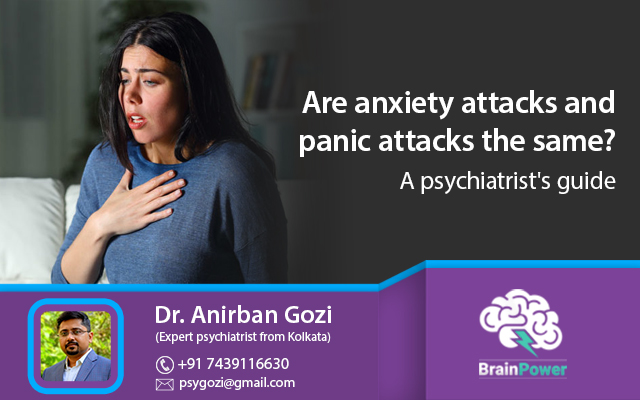People mistakenly think that panic attacks and anxiety are the same things, but the reality is a bit different. These are entirely different from each other. The symptoms and the issues caused by those are way apart. The Diagnostic and Statistical Manual 5th Edition of the American Psychological Association (APA) does not recognise the term “anxiety attack” (DSM-V).
Panic attacks, on the other hand, are classified as a symptom of panic disorder in the DSM-V.
The best psychiatrist Dr. Anirban Gozi vastly discussed panic attacks and anxiety. According to Dr. Gozi, anxiety is a long-term condition that does not manifest itself in attacks. He also clarified that it may or may not be stress-related, as in generalised anxiety disorder, where anxiety is free-floating.
Panic Attacks
These are sudden attacks, persisting for few minutes to several hours and generating intense fear. As a result, you suffer from physical symptoms such as nausea, shortness of breath, and a racing heartbeat. Panic attacks have been categorized as expected and unexpected by the Diagnostic and Statistical Manual of Mental Disorder (DSM-5). Random attacks may occur at any time, and there might not be a definite cause behind it, whereas, in the case of expected panic attacks, some preconceived fear may trigger. These external stressors are known as phobias, as per the best psychiatrist. Anybody can get a panic attack, but if it occurs more than once, it must not be ignored as it can result from panic disorder.
Anxiety
Anxiety is a state of mind marked by tense feelings, concerned thoughts, and physical changes such as elevated blood pressure. Anxiety disorders are characterised by recurrent intrusive thoughts and concerns. People with anxiety avoid certain situations because they are usually worried. Physical symptoms such as sweating, trembling, disorientation, or a rapid heartbeat may also be present. The source of your anxiety can be connected to some of your stressful experiences. The symptoms of anxiety disorder vary from person to person.
Symptoms
Symptoms of anxiety and panic attacks are divided into two segments. Those are as follows:
- Emotional
- Physical
Emotional symptoms may include:
- Fear about some situation or event
- Distress
- Restlessness
- Tension, apprehension, and worry
In the case of panic attacks, the most prevalent symptom is the fear of dying and losing control over things. A person experiencing panic attacks suffers from a sense of detachment. He/ she feels alone and thinks that nobody cares, as in the world does not care about him/ her. The person may also feel detached from himself/ herself.
Physical symptoms may include:
- Unexplained chest pain
- Palpitation of heart or a racing heart
- Dry mouth
- Shortness of breath
- Sweating and hot flashes
- Trembling
- Becoming numb for the time being
- Stomach upset
- Headache
- Nausea
- Abdominal pain
- Dizziness
The Differences
Anxiety occurs from some stress or fear, whereas panic attacks may occur suddenly without a cause. Anxiety can be mild or moderate and at times severe, but panic attacks are always intense. Anxiety gets build up gradually, but panic attacks occur abruptly. Panic attacks affect your mood and behaviour as it triggers your fear or worries about something.
Final Thought
Be it recurrent anxiety or panic attack, the physical symptoms are mostly the same. None of these emotional and physical symptoms should be ignored. Visit Dr. Anirban Gozi, the best psychiatrist, and speak your heart out without any hesitation.

